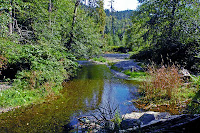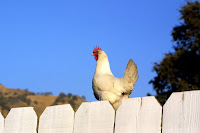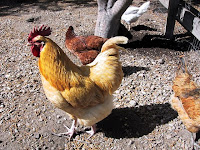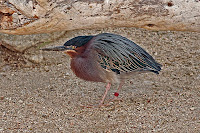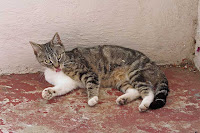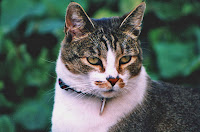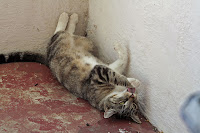
(Because Blogger doesn't let me move postings around, this second article is showing up first. If you haven't read Days At Sea Part 1, scroll down and do that first.)
Wednesday and we are all day on the ocean waters without going ashore. I sleep in because lying prone I am not dizzy and when sleeping I can't tell if the ship is moving or not. This is my cure for Malaise del Mar and seemed better than taking pills – but I took those too!
So aside from sleeping, what is there to do while trapped on board sailing? Well, on this ship you can gamble. No thank you. You can play bingo. No th
 ank you. Shop. Too expensive. Go to the Spa. Really too expensive. Attend the Battle of the Sexes Game Show. Good grief. Oh yes, and drink. Are you serious? While rolling and pitching? There are special events like the guy hawking diamonds and emeralds in the Grand Atrium who got on at the last port and gets off at the next. Or you can listen to the intense little fellow hawking the benefits of acupuncture in the Pearl Martini Lounge or learn about anti-aging solutions in the "Look Younger in Just Minutes" presentation in the Gatsby's Lounge or better yet, make a fool of yourself and do Karaoke. Oh, God help me!
ank you. Shop. Too expensive. Go to the Spa. Really too expensive. Attend the Battle of the Sexes Game Show. Good grief. Oh yes, and drink. Are you serious? While rolling and pitching? There are special events like the guy hawking diamonds and emeralds in the Grand Atrium who got on at the last port and gets off at the next. Or you can listen to the intense little fellow hawking the benefits of acupuncture in the Pearl Martini Lounge or learn about anti-aging solutions in the "Look Younger in Just Minutes" presentation in the Gatsby's Lounge or better yet, make a fool of yourself and do Karaoke. Oh, God help me!Our group had two nice lectures by Jim Covel from the Monterey Aquarium, "Life on the Edge" in the morning and "Our Oceans" in the afternoon and that night I did another digital photography workshop. In between I read the real life adventures of some fool who took a job on a cruise ship. Why would anyone who isn't trying to escape from a communist nation do that?
We did enjoy lunch and dinner as usual but not with the captain. Usually on cruise ships there is a dinner with the captain. Not on the Norwegian Star. If you wanted to dine with the captain you had to go below into the hold and eat with the crew. I don't know, maybe the captain was shy. But the absence of the captain's dinner did irk some members of our group. They did finally assuage their desire for some kind of audience with the guy driving the ship by signing up to have a formal picture taken with the captain. I'll bet he just loved that!

Day four and before sunrise we slide under the Golden Gate Bridge in the fog entering into San Francisco Bay. I peek out the messy porthole window to film us passing under some bridge in the misty dark that turns out to be the Oakland Bay Bridge and we dock next to it. Then right after breakfast we are on our bus and off to Marin County for a tour of the Marine Mammal Center.
The Cent
 er is the ultimate ending-up place for critters that need rehabilitation due to illness or injury. This year, like so many years past, there are many sick California sea lions suffering from domoic acid poisoning. The Center has nice new facilities for their patient
er is the ultimate ending-up place for critters that need rehabilitation due to illness or injury. This year, like so many years past, there are many sick California sea lions suffering from domoic acid poisoning. The Center has nice new facilities for their patient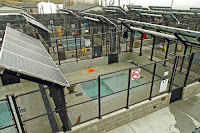 s and a wonderful staff and volunteers who care for the ailing sea mammals. We get to watch as the volunteers and the vets do a first time check-up on a new sea lion patient.
s and a wonderful staff and volunteers who care for the ailing sea mammals. We get to watch as the volunteers and the vets do a first time check-up on a new sea lion patient.This facility has come a long way since my last visit of about six years ago when the pens were a bit primitive and there were no labs or kitchens as there are now. At that time the staff did necropsies on dead marine mammals in the back of a shed. It was really great to see how they have advanced and how this certainly contributes to giving better care to these unfortunate animals.

Our next stop was back in the city at Golden Gate Park for our afternoon the California Academy of Sciences. Now, I could spend days in this place and know that surely a return visit will have to happen. The museum has a planetarium, a rainforest, a two and one-half acre rooftop covered in native grasses and plants, and many interactive exhibits. They have a Philippine coral reef, an African Hall with live penguins, a swamp, Islands of Evolution, an aquarium with 38,000 animals, and more.
We knew we had to see the planetarium and take a ride to the edge of the universe, an
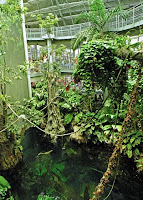 d then it was on to the Rainforest, a four story exhibit that is seen by traversing the walkway starting in the treetops of Costa Rica and wending down to the flooded Amazon floor. On the way there are tropical plants, free-flying equatorial birds and butterflies, chameleons from Madagascar, a bat cave from Borneo, and on the bottom an underwater tunnel where you gaze up at piranha and catfish. This was a photographic heaven and I could have spent hours taking pictures of the vibrantly colored butterflies and birds. But I had to see it all, so next it was up to the rooftop.
d then it was on to the Rainforest, a four story exhibit that is seen by traversing the walkway starting in the treetops of Costa Rica and wending down to the flooded Amazon floor. On the way there are tropical plants, free-flying equatorial birds and butterflies, chameleons from Madagascar, a bat cave from Borneo, and on the bottom an underwater tunnel where you gaze up at piranha and catfish. This was a photographic heaven and I could have spent hours taking pictures of the vibrantly colored butterflies and birds. But I had to see it all, so next it was up to the rooftop.Here there a
 re seven grass and flower covered hummocks with weird looking porthole windows that let light into the area below. This living roof provides insulation, absorbs rainwater preventing runoff, and is a habitat for area birds, butterflies and insects. It qualifies the museum as a truly green building.
re seven grass and flower covered hummocks with weird looking porthole windows that let light into the area below. This living roof provides insulation, absorbs rainwater preventing runoff, and is a habitat for area birds, butterflies and insects. It qualifies the museum as a truly green building.Our afternoon ended too soon and we were due back on board ship to sail once again. That night we learned more about our night sky from a presentation by Rouvaishyana, our state park ranger, entitled "International Year of Astronomy 2009." After that we all felt like going up on the top deck to look at stars and w probably would have if we weren't too pooped and if it hadn't been overcas
 t.
t.Our next day was another day at sea with two lectures by Jim called "Oceans of Inspiration" and "Our California Heritage." It was that or attend the towel animal folding demonstration or buy Colombian emeralds at 50% off. Oh no!
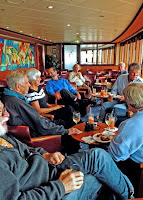
We did have a truly fun time way up top above the bridge looking for whales before going in for an hour long private reception in the Star Bar where we found out that some state park rangers could moonlight as piano bar entertainers. After munching hors d'ouevres and downing Caribbean drinks, we still had room for a last dinner in the dining room and then another night sleeping on the rolling ocean.
I will spar
 e you all the agony of our last day's departure at the port of Los Angeles except to say that if the port does not have elevator facilities working then they shouldn't allow people off ships dragging their stuffed 75 pound luggage behind them. I don't know. Others managed not to kill themselves bumping their suitcases down two flight of stairs or perching precariously with them on a swift moving escalator, but I knew better than to even try that. And it didn't matter. I could have waited and gotten off later when the elevator was running because the bus we were supposed to get promptly at 9 AM didn't go to the Los Angeles port. It was waiting for us at the Queen Mary in Long Beach. Didn't someone tell the bus driver, the Queen Mary no longer sails. It's a hotel.
e you all the agony of our last day's departure at the port of Los Angeles except to say that if the port does not have elevator facilities working then they shouldn't allow people off ships dragging their stuffed 75 pound luggage behind them. I don't know. Others managed not to kill themselves bumping their suitcases down two flight of stairs or perching precariously with them on a swift moving escalator, but I knew better than to even try that. And it didn't matter. I could have waited and gotten off later when the elevator was running because the bus we were supposed to get promptly at 9 AM didn't go to the Los Angeles port. It was waiting for us at the Queen Mary in Long Beach. Didn't someone tell the bus driver, the Queen Mary no longer sails. It's a hotel.Did I enjoy the trip? Absolutely! Would I do it again? Not a chance.


Our Stateroom on the 4th Deck just above Crew Quarters

Norwegian Star Pool Deck
Towel Animal

Marine Mammal Center - Treating a sea lion

Marine Mammal Center Treatment Board

Marine Mammal Center Scientists at work
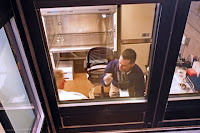
 Violaceous euphonia - tropical bird in Rainforest exhibit at California Academy of Science
Violaceous euphonia - tropical bird in Rainforest exhibit at California Academy of Science Tropical Butterflies at California Academy of Science
Tropical Butterflies at California Academy of Science




